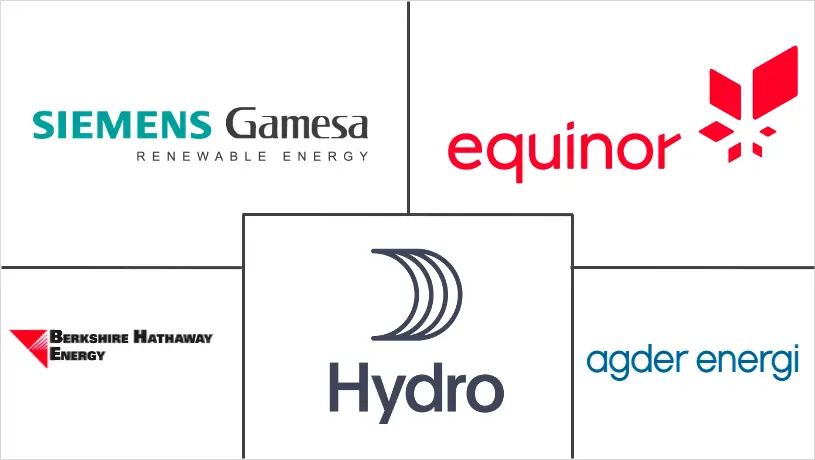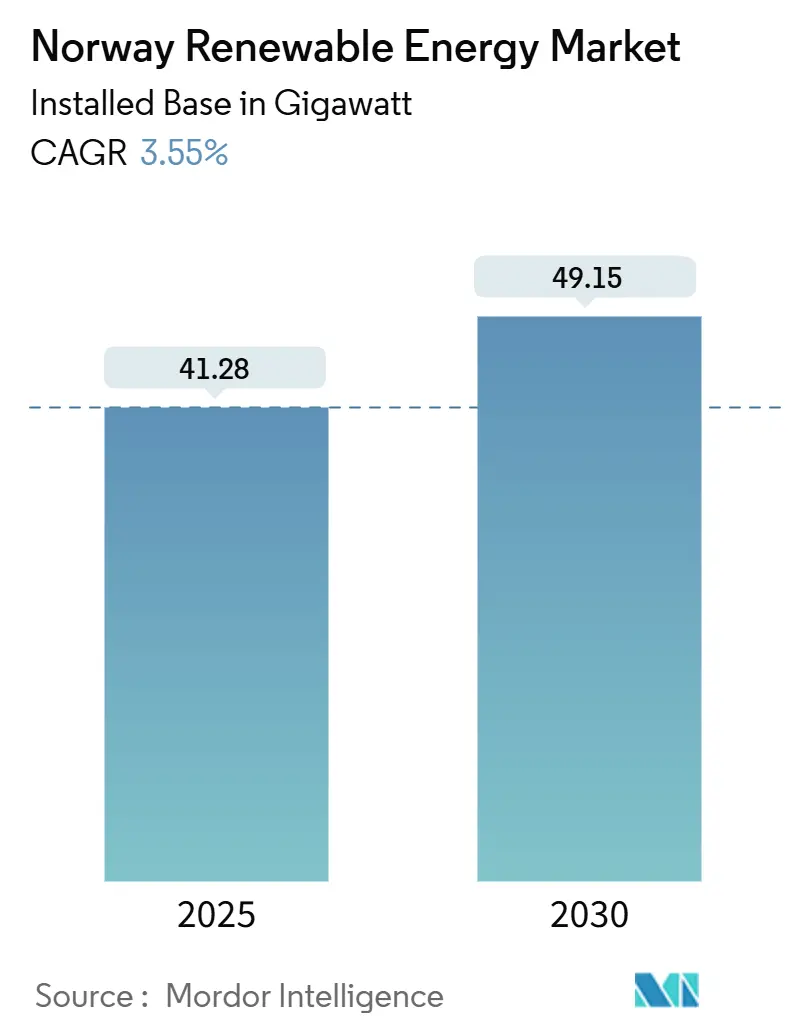
Norway Renewable Energy Market Analysis by Mordor Intelligence
The Norway Renewable Energy Market size in terms of installed base is expected to grow from 41.28 gigawatt in 2025 to 49.15 gigawatt by 2030, at a CAGR of 3.55% during the forecast period (2025-2030).
High-head hydropower still supplies the country’s baseload, but seasonal oversupply drives negative Nordic spot prices that favor long-duration storage, merchant exports, or long-term power-purchase agreements. Floating-platform innovations are opening deep-water areas, while bifacial solar shows unexpected productivity in snow-reflection conditions. Corporate decarbonization mandates, especially for data centers and aluminum smelters, translate into premium-priced 24/7 carbon-free PPAs that underwrite new capacity.
Key Report Takeaways
- By technology, hydropower commanded 85.2% of the Norway renewable energy market share in 2024, while solar energy is forecast to expand at a 36.5% CAGR through 2030.
- By end-user, utilities held 69.5% of the Norway renewable energy market size in 2024, whereas the commercial and industrial segment is advancing at a 6.8% CAGR between 2025 and 2030.
- Statkraft and Equinor together controlled about 45% of installed capacity in 2024, giving them the single largest slice of the Norway renewable energy market share.
Norway Renewable Energy Market Trends and Insights
Drivers Impact Analysis
| Driver | (~) % Impact on CAGR Forecast | Geographic Relevance | Impact Timeline |
|---|---|---|---|
| Hydro-dominant grid limits CO₂ emissions | +0.30% | National | Long term (≥ 4 years) |
| 50 Hertz interconnector boosts export revenues | +0.70% | Southern Norway–Germany | Medium term (2–4 years) |
| Mandatory data-center electrification (2025) | +0.90% | Northern Norway | Short term (≤ 2 years) |
| Offshore wind auction scheme | +1.20% | North Sea coastal zones | Long term (≥ 4 years) |
| Aluminium smelters locking 15-year PPAs | +0.50% | Western industrial clusters | Medium term (2–4 years) |
| Glacier-melt inflow to reservoirs | +0.40% | Mountain catchments | Short term (≤ 2 years) |
| Source: Mordor Intelligence | |||
Hydro-Dominant Grid Limits CO₂ Emissions
Norway’s power system emitted only 6 g CO₂/kWh in 2024, setting an ultra-low baseline that shifts investment away from coal displacement and toward hard-to-abate sectors. Utilities monetize this advantage through hour-by-hour certificates that guarantee carbon-free supply to data-center tenants. Strict grid-code compliance under EU Regulation 2016/631 keeps system stability high even with more variable generation. Equinor’s co-location of solar arrays beside hydro substations cuts interconnection waiting times and leverages existing transformers. The broader signal is that incremental decarbonization now depends on transport and industry electrification rather than new domestic renewables capacity.
50 Hertz Interconnector Boosts Export Revenues
The 1.4 GW NordLink and twin North Sea Link cables exported 8.2 TWh to Germany and the United Kingdom in 2024, earning Norwegian generators EUR 820 million in price arbitrage.[1]“NordLink Record Export Volumes,” Statnett, statnett.noOff-shore wind developers expect similar uplift because Sørlige Nordsjø II output can clear into German peak hours at EUR 100+/MWh while local prices sit near zero. Statnett will invest NOK 30 billion in internal reinforcements that unlock more north–south flow and raise interconnector utilization. EU rules calling for 70 % cross-border capacity, though not binding on Norway, raise pressure to deepen links that anchor the Norway renewable energy market to Continental demand.
Mandatory Data-Center Electrification (2025)
A 2025 decree obliges every new data center to procure 100 % renewables with real-time matching, a threshold stricter than existing EU efficiency proposals.[2]Norwegian Ministry of Climate and Environment, “Data Center Renewable Mandate,” regjeringen.noAker Horizons plans 500 MW of data-center capacity in Narvik and Mo i Rana, exploiting sub-Arctic cooling and nearby hydro surpluses. Statkraft’s 24/7 carbon-free PPAs fetch premiums 20-30 % above standard contracts, creating bankable revenue for new build. The data-protection authority mandates monthly disclosure of sourcing, bolstering transparency. These rules differentiate Norway from neighboring Sweden and Finland, drawing hyperscaler demand northward and enlarging the Norway renewable energy market.
Offshore Wind Auction Scheme
Government auctions covering 1.5 GW at Utsira Nord and 3 GW at Sørlige Nordsjø II will finalize in 2025, with first steel expected in 2027. Utsira Nord’s 200-300 m depths require floating foundations; Equinor holds seven operational patents here, leveraging Hywind experience. Principle Power’s WindFloat platform secured a EUR 60 million European Investment Bank loan to commercialize 15 MW turbines at 500 m depth. In the shallower Sørlige Nordsjø II area, Ørsted and Vattenfall have submitted seabed surveys for fixed-bottom bids. Auction rules omit contracts-for-difference, so developers must secure merchant offtake or corporate PPAs, concentrating risk but rewarding projects with interconnector access.
Restraints Impact Analysis
| Restraint | (~) % Impact on CAGR Forecast | Geographic Relevance | Impact Timeline |
|---|---|---|---|
| Grid bottlenecks NO2–NO5 price areas | -0.60% | Southern–Northern corridors | Medium term (2–4 years) |
| Reindeer-herding land-use conflicts | -0.40% | Sámi regions | Long term (≥ 4 years) |
| Slow permitting for onshore turbines | -0.50% | National | Medium term (2–4 years) |
| Negative Nordic spot prices | -0.70% | Synchronous Nordic area | Short term (≤ 2 years) |
| Source: Mordor Intelligence | |||
Grid Bottlenecks NO2–NO5 Price Areas
Congestion between southern (NO2) and northern (NO5) zones produced EUR 80/MWh price gaps and stranded northern generation in 2024. Statnett will spend NOK 30 billion on 420 kV upgrades, yet the first energization will arrive only in 2028. Curtailment trims northern wind capacity factors by 8–12 %, eroding returns. Developers thus face a spatial trade-off: costly land near load or cheaper remote sites with curtailment risk. Until reinforcement completes, project economics across the Norway renewable energy market hinge on north–south power-flow relief.
Reindeer-Herding Land-Use Conflicts
The Supreme Court’s Fosen ruling found 151 turbines breached Sámi grazing rights, setting a precedent that has stalled 1.2 GW of onshore wind.[3]Norwegian Ministry of Climate and Environment, “Data Center Renewable Mandate,” regjeringen.no Sámi Parliament consent is now required, extending approvals beyond 1,000 days. Statkraft canceled three Finnmark projects, writing off NOK 180 million in sunk costs. New guidelines demand ethnographic impact assessments and revenue sharing, but permitting lags persist. Capital is therefore pivoting offshore, where seabed leases avoid indigenous land claims, reshaping the Norway renewable energy market toward floating wind.
Segment Analysis
By Technology: Floating Platforms Unlock Deep-Water Wind
Hydropower held an 85.2 % share of the Norway renewable energy market size in 2024, anchored by 33 GW of installed dams and pumped-storage units. Yet new dam approvals face environmental pushback, so pumped-storage upgrades such as Illvatn now dominate hydro capex. Solar energy is projected to post a 36.5 % CAGR through 2030, with bifacial panels in Stavanger showing 18 % annual capacity factors that validate PV at 60° N latitude. Wind energy contributed roughly 10 % of capacity but will accelerate once 4.5 GW of Utsira Nord and Sørlige Nordsjø II installations enter service after 2028, most of them on floating foundations. Ocean energy and bioenergy together account for less than 2 % today; however, grants under the ENERGIX program sustain R&D pipelines that might reach commercial scale after 2030. The technology mix therefore bifurcates: mature hydro secures flexibility, while fast-rising solar and floating wind drive incremental volume in the Norway renewable energy market.
The Norway renewable energy market share for hydropower will gradually erode as new offshore wind displaces its portion of installed GW, but pumped-storage keeps hydro central to balancing duties. Solar’s sharp cost decline below USD 0.15/W tilts commercial rooftops toward self-generation, although grid buy-back rates remain wholesale. Floating platforms are unlocking 200-400 m depths that dominate Norway’s continental shelf, creating a first-mover advantage for patent holders such as Equinor and Principle Power. Fixed-bottom projects nearer shore still win on levelized cost but face seabed constraints. Bioenergy remains concentrated in waste-to-energy plants like BIR’s Voss facility, which converts organic waste into biomethane for district heat. Overall, portfolio diversification is enhancing resilience and attracting capital even under mature-market growth rates.
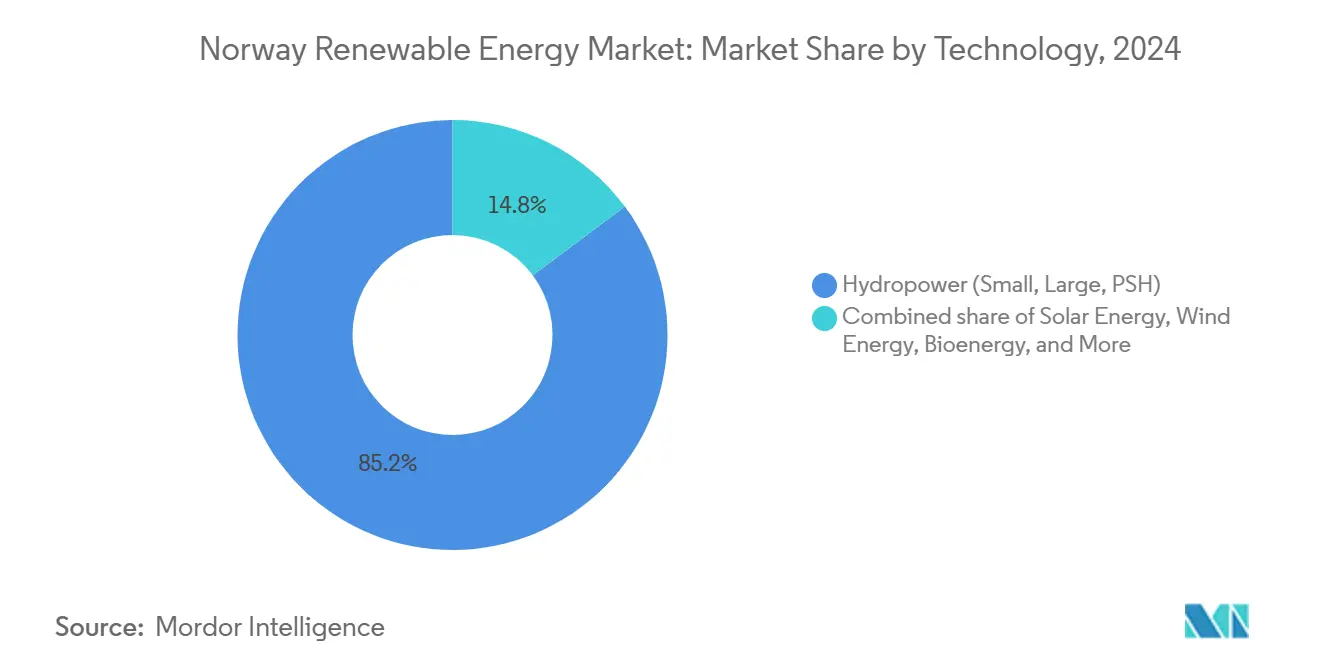
Note: Segment shares of all individual segments available upon report purchase
By End-User: Hyperscalers Compete With Smelters for PPAs
Utilities controlled 69.5 % of the Norway renewable energy market size in 2024, reflecting state ownership and balancing responsibilities. Commercial and industrial customers are expanding at a 6.8 % CAGR as smelters and data centers lock 10–15-year carbon-free PPAs. The Norway renewable energy market share commanded by utilities will gradually shrink if hyperscaler load accelerates after 2025. Norsk Hydro’s 2.5 TWh/year PPA and Aker Horizons’ planned 500 MW data-center load exemplify how corporates pre-empt generation to secure flat pricing. Residential demand grows just 2 % per year because wholesale-based net metering limits rooftop solar attraction.
Corporate PPAs now underpin financing stacks for floating-wind arrays, reducing merchant-revenue exposure and letting sponsors raise higher debt ratios. Competition authorities view these contracts as pro-competitive because they damp spot-price volatility and stimulate new builds. Utilities still dominate balancing services and ancillary-market revenues, but long-duration storage projects could let industrial buyers internalize flexibility over time. If data-center mandates broaden beyond new facilities to cover existing sites, the commercial and industrial share may overtake utilities by 2035. The Norway renewable energy market thus transitions toward a corporate-PPA equilibrium in which large off-takers shape project pipelines.
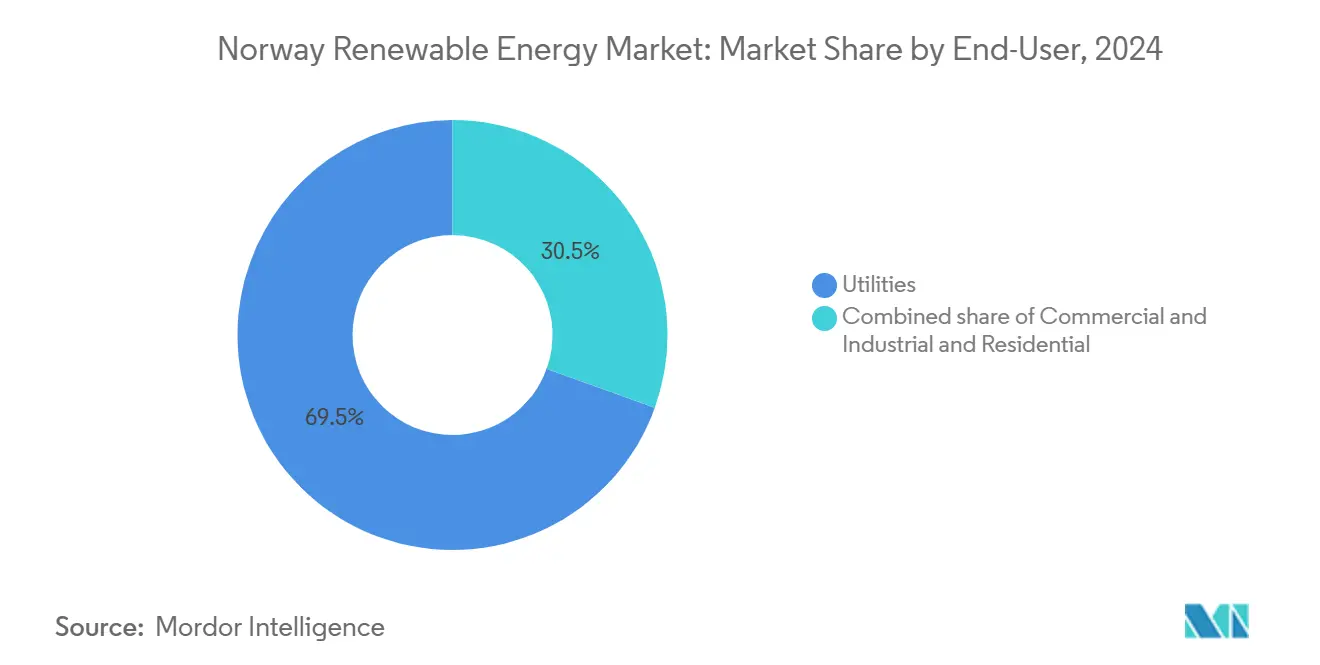
Note: Segment shares of all individual segments available upon report purchase
Geography Analysis
Hydropower clusters along steep valleys in Vestland and Rogaland, which together house 45 % of installed capacity, while North Sea winds favor nearby floating-wind zones.[4]Norwegian Water Resources and Energy Directorate, “Power Generation by Region,” nve.no Northern regions (NO4 and NO5) host 30 % of hydro and much of the best onshore-wind resource, yet transmission bottlenecks strand energy and create EUR 80/MWh price splits versus the south. Statnett’s NOK 30 billion reinforcement aims to lift north-to-south transfer by 1.2 GW, allowing surplus hydro and wind to reach Continental interconnectors. Southern Norway, chiefly NO2, draws solar development because of better irradiance and proximity to demand; Equinor’s 12 MW Stavanger rooftop verified PV viability at high latitude.
Utsira Nord and Sørlige Nordsjø II lie off the West Coast, ensuring export alignment with German demand via NordLink and forthcoming HVDC links. Conversely, Sámi land-use conflicts have frozen 1.2 GW of onshore wind in Finnmark and Troms, redirecting capital to offshore sites where seabed leases avoid indigenous overlaps. Aker Horizons’ data-center campuses in Narvik and Mo i Rana co-locate load with stranded renewables, sidestepping curtailment risk and setting a model for future industrial siting. Geography thus underpins a dual market: southern zones feed Europe and attract offshore wind, northern zones court on-site loads to monetize surplus power.
The Norway renewable energy market will stay spatially divided until the NO2–NO5 backbone energizes in 2028. After that, hydro reservoirs in the north should flexibly supply Continental peaks, while floating wind in the south exports premium volumes. Solar, though relatively small in absolute terms, will cluster near urban demand centers where rooftops lower land-use friction. Region-specific policies, indigenous rights, and cable capacity, therefore, shape the geographic mosaic of growth.
Competitive Landscape
The Norway renewable energy market exhibits moderate concentration: Statkraft and Equinor together hold roughly 45 % of installed capacity and dominate offshore-wind acreage. Vestas remains the leading onshore turbine OEM with a 40 % fleet share, followed by Siemens Gamesa and Nordex. Aker Horizons spans floating foundations, green hydrogen, and data-center development, positioning itself as an integrated play from generation through end use. Smaller specialists such as Scatec in solar EPC and Flumill in tidal turbines target high-growth niches beyond the hydro-and-wind mainstream.
Strategic themes point to risk migration away from merchant exposure toward contracted revenues. Statkraft’s 24/7 carbon-free structure matches generation hourly with load, allowing developers to lever projects at 70 % debt or higher. Equinor’s 2024 patent for a tension-leg floater with integrated 50 MWh battery storage signals a move to hybrid systems that combine generation and flexibility. The Norwegian Petroleum Directorate awards seabed licenses based on technical track record, which favors incumbents and may slow new-entrant penetration.
Competition centers on supply-chain localization: Principle Power will assemble WindFloat foundations domestically under its EIB-backed scale-up, while ABB won a NOK 4.5 billion contract for HVDC converter stations that reinforce internal grids. Turbine vendors differentiate via power-curve guarantees suited to Norway’s high-turbulence maritime climate. As solar installations multiply, EPC firms with cold-climate snow-shedding expertise gain share. Overall, the Norway renewable energy market rewards players that blend technology leadership with long-term offtake contracting.
Norway Renewable Energy Industry Leaders
-
Norsk Hydro ASA
-
Agder Energi AS
-
Equinor ASA
-
Berkshire Hathaway Energy Co
-
Siemens Gamesa Renewable Energy S.A.,
- *Disclaimer: Major Players sorted in no particular order
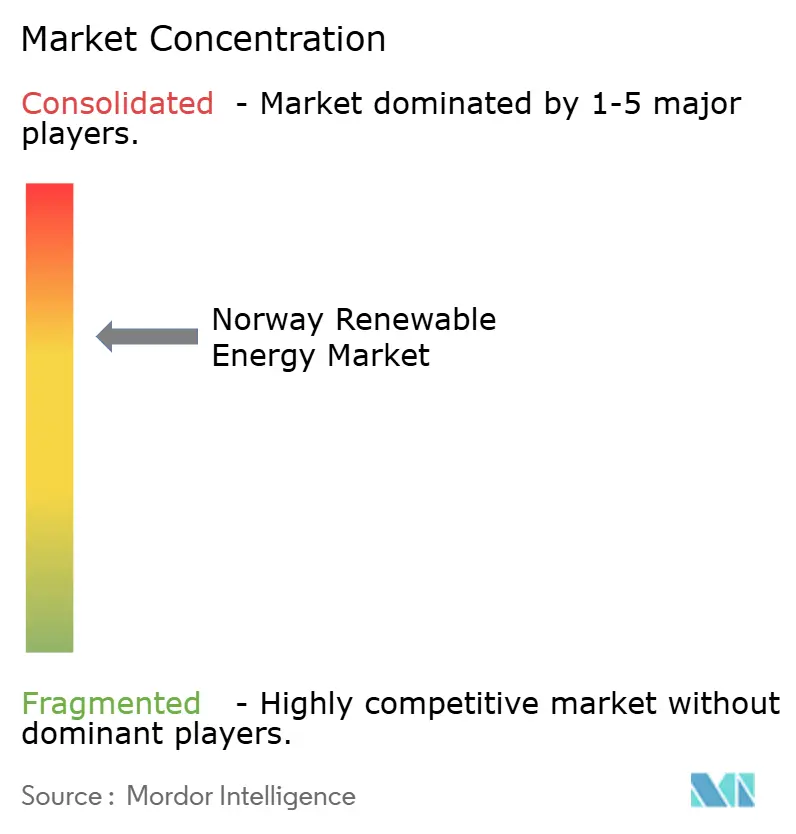
Recent Industry Developments
- March 2025: Aker Horizons announced plans to develop 500 MW of data-center capacity in Narvik and Mo i Rana, targeting hyperscaler tenants and leveraging northern Norway's stranded renewable capacity and sub-Arctic cooling. The project represents an estimated USD 600 million investment and is expected to commission its first phase in 2027, adding 1.2 TWh of annual electricity demand.
- February 2025: Statnett awarded a NOK 4.5 billion (USD 420 million) contract to ABB for HVDC converter stations to reinforce the NO2-NO5 transmission corridor, with completion targeted for 2028. The upgrade will increase north-south transfer capacity by 1.2 GW, reducing curtailment of northern hydro and wind generation.
- January 2025: Equinor filed a patent application for a tension-leg floating offshore wind platform with integrated 50 MWh battery storage, designed to smooth output variability and improve merchant-revenue capture. The design targets water depths of 200-400 meters, matching conditions in the Utsira Nord auction zone.
- December 2024: Norsk Hydro secured final regulatory approval from NVE for its 1,120 MW Illvatn pumped-storage project in Telemark, with construction start scheduled for Q2 2025 and commissioning in 2030. The facility will provide 8 hours of storage, equivalent to 8.96 GWh, to balance intermittent wind and solar output.
- October 2024: Aker Horizons' Principle Power subsidiary secured a EUR 60 million loan from the European Investment Bank to scale production of its WindFloat semi-submersible platform, which can host 15 MW turbines in water depths up to 500 meters. The funding supports deployment in the Utsira Nord zone.
Norway Renewable Energy Market Report Scope
Renewable energy is derived from natural sources that replenish faster than they are consumed, such as sunlight, wind, water, geothermal heat, and biomass. These resources are considered inexhaustible and are used to generate electricity, heat, and fuel, typically resulting in a lower carbon footprint and reduced environmental impact compared to fossil fuels.
The Norwegian Renewable Energy Market is segmented by technology and end-user. By technology, the market is segmented by Solar Energy (PV and CSP), Wind Energy (Onshore and Offshore), Hydropower (Small, Large, PSH), Bioenergy, Geothermal, Ocean Energy (Tidal and Wave). By end user, the market is segmented into Utilities, Commercial and Industrial, and Residential. The report also covers the market size and forecasts for Norway.
For each segment, the market sizing and forecasts have been done based on the installed capacity (GW).
| Solar Energy (PV and CSP) |
| Wind Energy (Onshore and Offshore) |
| Hydropower (Small, Large, PSH) |
| Bioenergy |
| Geothermal |
| Ocean Energy (Tidal and Wave) |
| Utilities |
| Commercial and Industrial |
| Residential |
| By Technology | Solar Energy (PV and CSP) |
| Wind Energy (Onshore and Offshore) | |
| Hydropower (Small, Large, PSH) | |
| Bioenergy | |
| Geothermal | |
| Ocean Energy (Tidal and Wave) | |
| By End-User | Utilities |
| Commercial and Industrial | |
| Residential |
Key Questions Answered in the Report
How large is the Norway renewable energy market today?
Installed capacity reached 41.28 GW in 2025 and is forecast to grow to 49.15 GW by 2030 at a 3.55 % CAGR.
Which technology is growing the fastest in Norway’s power mix?
Solar energy leads with a projected 36.5 % CAGR through 2030, thanks to falling module prices and long summer daylight.
Why are corporate PPAs important in Norway?
Long-term contracts with smelters and data centers stabilize cash flows, enabling developers to finance new offshore-wind and solar projects.
What is delaying onshore-wind expansion?
Permitting now takes more than 1,000 days due to expanded environmental reviews and Sámi land-use concerns.
How will grid bottlenecks be addressed?
Statnett is investing NOK 30 billion to reinforce the NO2–NO5 corridor, boosting north–south transfer capacity by 1.2 GW by 2028.
Page last updated on:
